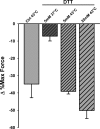Thermal tolerance of contractile function in oxidative skeletal muscle: no protection by antioxidants and reduced tolerance with eicosanoid enzyme inhibition
- PMID: 18768765
- PMCID: PMC2584865
- DOI: 10.1152/ajpregu.90429.2008
Thermal tolerance of contractile function in oxidative skeletal muscle: no protection by antioxidants and reduced tolerance with eicosanoid enzyme inhibition
Abstract
Mechanisms for the loss of muscle contractile function in hyperthermia are poorly understood. This study identified the critical temperature, resulting in a loss of contractile function in isolated diaphragm (thermal tolerance), and then tested the hypotheses 1) that increased reactive oxygen species (ROS) production contributes to the loss of contractile function at this temperature, and 2) eicosanoid metabolism plays an important role in preservation of contractile function in hyperthermia. Contractile function and passive force were measured in rat diaphragm bundles during and after 30 min of exposure to 40, 41, 42 or 43 degrees C. Between 40 and 42 degrees C, there were no effects of hyperthermia, but at 43 degrees C, a significant loss of active force and an increase in passive force were observed. Inhibition of ROS with the antioxidants, Tiron or Trolox, did not inhibit the loss of contractile force at 43 degrees C. Furthermore, treatment with dithiothreitol, a thiol (-SH) reducing agent, did not reverse the effects of hyperthermia. A variety of global lipoxygenase (LOX) inhibitors further depressed force during 43 degrees C and caused a significant loss of thermal tolerance at 42 degrees C. Cyclooxygenase (COX) inhibitors also caused a loss of thermal tolerance at 42 degrees C. Blockage of phospholipase with phospholipase A(2) inhibitors, bromoenol lactone or arachidonyltrifluoromethyl ketone failed to significantly prevent the loss of force at 43 degrees C. Overall, these data suggest that ROS do not play an apparent role in the loss of contractile function during severe hyperthermia in diaphragm. However, functional LOX and COX enzyme activities appear to be necessary for maintaining normal force production in hyperthermia.
Figures






Similar articles
-
Intra- and extracellular measurement of reactive oxygen species produced during heat stress in diaphragm muscle.Am J Physiol Cell Physiol. 2000 Oct;279(4):C1058-66. doi: 10.1152/ajpcell.2000.279.4.C1058. Am J Physiol Cell Physiol. 2000. PMID: 11003586
-
Molecular modelling insights into a physiologically favourable approach to eicosanoid biosynthesis inhibition through novel thieno[2,3-b]pyridine derivatives.J Enzyme Inhib Med Chem. 2018 Dec;33(1):755-767. doi: 10.1080/14756366.2018.1457657. J Enzyme Inhib Med Chem. 2018. PMID: 29651867 Free PMC article.
-
24R,25-(OH)(2)D(3) mediates its membrane receptor-dependent effects on protein kinase C and alkaline phosphatase via phospholipase A(2) and cyclooxygenase-1 but not cyclooxygenase-2 in growth plate chondrocytes.J Cell Physiol. 2000 Mar;182(3):390-401. doi: 10.1002/(SICI)1097-4652(200003)182:3<390::AID-JCP10>3.0.CO;2-T. J Cell Physiol. 2000. PMID: 10653606
-
Eicosanoids.Essays Biochem. 2020 Sep 23;64(3):423-441. doi: 10.1042/EBC20190083. Essays Biochem. 2020. PMID: 32808658 Review.
-
Nitric oxide, reactive oxygen species, and skeletal muscle contraction.Med Sci Sports Exerc. 2001 Mar;33(3):371-6. doi: 10.1097/00005768-200103000-00006. Med Sci Sports Exerc. 2001. PMID: 11252061 Review.
Cited by
-
Hyperthermia increases interleukin-6 in mouse skeletal muscle.Am J Physiol Cell Physiol. 2012 Aug 15;303(4):C455-66. doi: 10.1152/ajpcell.00028.2012. Epub 2012 Jun 6. Am J Physiol Cell Physiol. 2012. PMID: 22673618 Free PMC article.
-
Uncovering Diaphragm Cramp in SIDS and Other Sudden Unexpected Deaths.Diagnostics (Basel). 2024 Oct 18;14(20):2324. doi: 10.3390/diagnostics14202324. Diagnostics (Basel). 2024. PMID: 39451647 Free PMC article.
-
Twelve hours of heat stress induces inflammatory signaling in porcine skeletal muscle.Am J Physiol Regul Integr Comp Physiol. 2016 Jun 1;310(11):R1288-96. doi: 10.1152/ajpregu.00494.2015. Epub 2016 Mar 23. Am J Physiol Regul Integr Comp Physiol. 2016. PMID: 27009052 Free PMC article.
-
Pre-hibernation diet alters skeletal muscle relaxation kinetics, but not force development in torpid arctic ground squirrels.J Comp Physiol B. 2024 Feb;194(1):65-79. doi: 10.1007/s00360-023-01527-z. Epub 2024 Jan 14. J Comp Physiol B. 2024. PMID: 38219236 Free PMC article.
-
Hyperthermia induces injury to the intestinal mucosa in the mouse: evidence for an oxidative stress mechanism.Am J Physiol Regul Integr Comp Physiol. 2012 Apr;302(7):R845-53. doi: 10.1152/ajpregu.00595.2011. Epub 2012 Jan 11. Am J Physiol Regul Integr Comp Physiol. 2012. PMID: 22237593 Free PMC article.
References
-
- Ackermann EJ, Conde-Frieboes K, Dennis EA. Inhibition of macrophage Ca(2+)-independent phospholipase A2 by bromoenol lactone and trifluoromethyl ketones. J Biol Chem 270: 445–450, 1995. - PubMed
-
- Ali SZ, Taguchi A, Rosenberg H. Malignant hyperthermia. Best Pract Res Clin Anaesthesiol 17: 519–533, 2003. - PubMed
-
- Anderson KM, Petrik D, Mullane K, Harris JE. Spontaneous chemiluminescence of ETYA (5,8,11,14-eicosatetraynoic acid) is inhibited by catalase or peroxidase. Prostaglandins Leukot Essent Fatty Acids 51: 271–275, 1994. - PubMed
-
- Balogh G, Horvath I, Nagy E, Hoyk Z, Benko S, Bensaude O, Vigh L. The hyperfluidization of mammalian cell membranes acts as a signal to initiate the heat shock protein response. FEBS J 272: 6077–6086, 2005. - PubMed
-
- Basivireddy J, Jacob M, Balasubramanian KA. Indomethacin induces free radical-mediated changes in renal brush border membranes. Arch Toxicol 79: 441–450, 2005. - PubMed
Publication types
MeSH terms
Substances
Grants and funding
LinkOut - more resources
Full Text Sources
Medical

